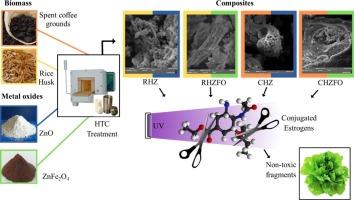使用生物质废弃物衍生的水碳复合材料作为光催化剂增强水中激素的光氧化反应
Q1 Environmental Science
引用次数: 0
摘要
本研究介绍了一种利用农用工业废物提高金属氧化物在光催化反应中催化效率的绿色化学方法。具体而言,研究人员利用稻壳和废咖啡渣作为碳源生产出水炭,作为氧化锌和锌铁氧化物的可持续支撑物。这种方法通过重新利用农业副产品,减少了传统催化剂生产对环境的影响,从而促进了废物最小化和循环利用。通过温和的水热碳化(250 °C,4 小时)合成了水合碳,并通过各种理化分析对其进行了表征。使用 20 mg L-1 的共轭雌激素溶液在紫外线(120 W cm-2)下照射 30 分钟,对它们的光催化性能进行了评估。由于孔隙率和富氧结构的增强,氧化锌复合材料的氧化反应速率显著提高。活性氧(ROS)分析表明,羟基自由基(OH)是主要物质,光催化效率在 11 次循环后超过 83%。在毒性试验中,将 4 毫升处理过的溶液涂抹在 20 颗莴苣种子上,在 25 °C 黑暗环境中保存 7 天。与对照组相比,接触过处理溶液的种子的胚根伸长率和发芽率都有所提高,但咖啡炭和氧化锌处理过的种子除外。这表明可以有效降解有毒的雌激素,且不会产生有害的副产品。总之,这项工作凸显了绿色化学原理与循环经济实践相结合的优势,将废物转化为有价值的材料,从而提高环境的可持续性和催化性能。本文章由计算机程序翻译,如有差异,请以英文原文为准。

Enhanced photo-oxidation of hormones in water using biomass waste-derived hydrochar composites as photocatalysts
This study introduces a green chemistry approach to enhance the catalytic efficiency of metal oxides in photocatalytic reactions using agro-industrial waste. Specifically, rice husks and spent coffee grounds were utilized as carbon sources to produce hydrochars, which served as sustainable supports for ZnO and ZnFe₂O₄ oxides. This method promotes waste minimization and circularity by repurposing agricultural byproducts, reducing the environmental impact of traditional catalyst production. The hydrochars were synthesized through mild hydrothermal carbonization (250 °C for 4 h) and characterized by various physicochemical analyses. Their photocatalytic performance was evaluated using a 20 mg L−1 solution of conjugated estrogens under ultraviolet light (120 W cm−2) for 30 min. Composites with ZnO exhibited a significant increase in oxidation reaction rates due to enhanced porosity and an oxygen-rich structure. Reactive oxygen species (ROS) analysis revealed hydroxyl radicals (![]() OH) as the primary agents, with photocatalytic efficiencies exceeding 83 % after eleven cycles. In toxicity tests, 4 mL of treated solution was applied to 20 Lactuca sativa (lettuce) seeds, kept in the dark at 25 °C for 7 days. Seeds exposed to treated solutions showed improved radicle elongation and germination rates compared to controls, except for those with coffee hydrochar and ZnO. This indicates effective degradation of toxic estrogens without harmful by-products. Overall, this work highlights the advantages of integrating green chemistry principles and circular economy practices, transforming waste into valuable materials to enhance environmental sustainability and catalytic performance.
OH) as the primary agents, with photocatalytic efficiencies exceeding 83 % after eleven cycles. In toxicity tests, 4 mL of treated solution was applied to 20 Lactuca sativa (lettuce) seeds, kept in the dark at 25 °C for 7 days. Seeds exposed to treated solutions showed improved radicle elongation and germination rates compared to controls, except for those with coffee hydrochar and ZnO. This indicates effective degradation of toxic estrogens without harmful by-products. Overall, this work highlights the advantages of integrating green chemistry principles and circular economy practices, transforming waste into valuable materials to enhance environmental sustainability and catalytic performance.
求助全文
通过发布文献求助,成功后即可免费获取论文全文。
去求助
来源期刊

Bioresource Technology Reports
Environmental Science-Environmental Engineering
CiteScore
7.20
自引率
0.00%
发文量
390
审稿时长
28 days
 求助内容:
求助内容: 应助结果提醒方式:
应助结果提醒方式:


